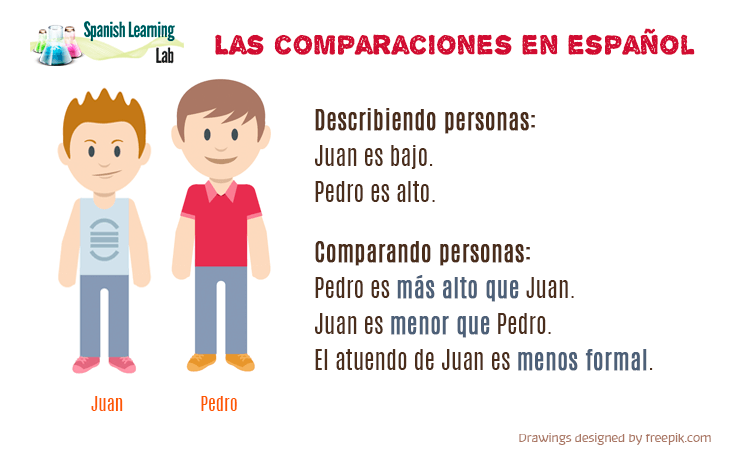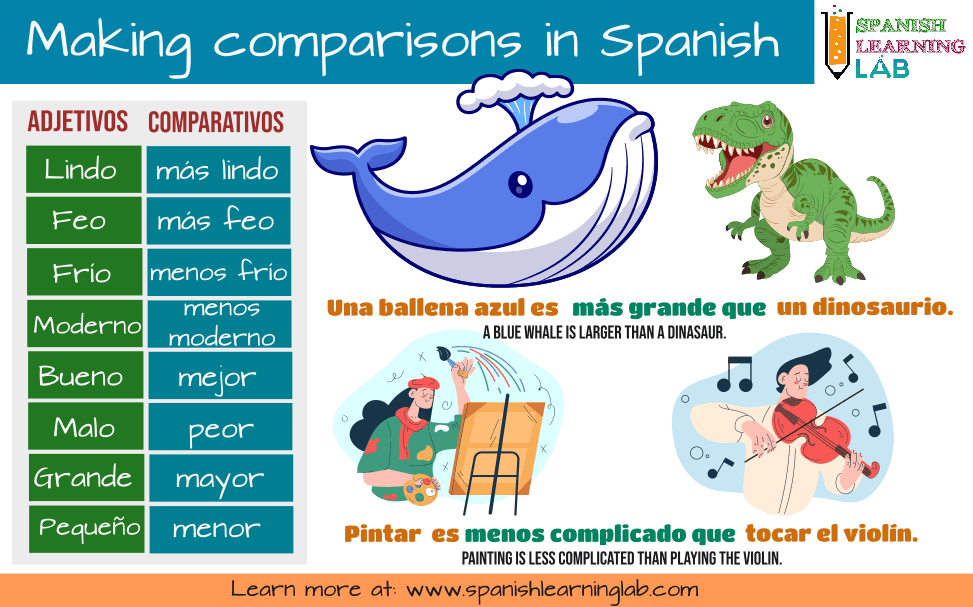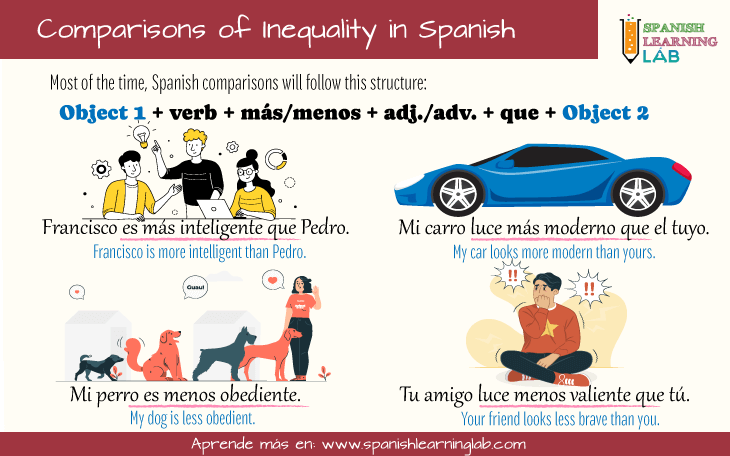¡Hola! Welcome to a new grammar lesson. Today, we will learn how to make basic comparisons of inequality in Spanish using “más/menos + adjectivos + que”. As usual, we will be using the grammar structure in several examples so that you can see how native speakers may use it in real scenarios. Besides, you will have the chance to practice with interactive quizzes. Let’s start…

The basic rules for making comparisons of inequality in Spanish
Being able to describe things is the first step to make comparisons in Spanish, which is why we will begin by talking about adjectives in Spanish. “Los adjetivos” are words that are used to describe things like the physical appearance and personality of people, the way places or any object looks like and so on. Adjectives are very commonly used along with the verb “SER” in its forms “ES” and “SON”, just like shown in these two sentences:
- Ella es alta. (She is tall)
- La ciudad es grande. (The city is big).
In order to make comparisons of inequality in Spanish, we will use the words MÁS (more) and MENOS (less) before adjectives like “alto” or “grande”, to say things like: “Más alto” (taller) and “Menos importante“ (less important). We will also have to add the equivalent for “THAN” after the adjectives, that is “QUE”, e.g. “Más alto que…” (taller than). Following this pattern, we could say things like:
- Aprender idiomas es menos complicado que aprender finanzas. (Learning languages is less complicated than learning finance.)

It is important to memorize the irregular form of a few comparatives, including the comparative form for the adjectives “bueno”, “malo” and others. For example, the adjective “bueno” (good) will be used as “mejor” (better) in its comparative form when indicating superior ability or appearance rather than “más bueno”, although “más bueno” will be used when referring to a comparison of generosity/kindness between people. Check the chart below and notice how some adjectives have irregular comparatives in Spanish.
| Original adjectives | Comparatives in Spanish |
|---|---|
| Alto | Más alto que / Menos alto que |
| Bonita | Más bonita que / Menos bonita que |
| Interesante | Más interesante que / Menos interesante que |
| Bueno | Mejor que |
| Malo | Peor que |
| Pequeño (for age) | Menor que |
| Grande | Mayor que |
Interactive quiz:
The sentence structure behind comparisons in Spanish
Now, we will go into more details about the structure of sentences related to comparisons of inequality in Spanish. Most comparisons in Spanish will follow the structure presented in the picture below. Try to analyze the sample sentences in it as carefully as possible:

As you can see, the sentence structure is very similar in both English and Spanish. If you want to make a negative sentence, then just place the word “NO” behind the main verb in the sentences, which could be SER (to be) or LUCIR (to look like), just like this:
- Él no es más alto que ella. (He is not taller than her.)
- Mis perros no son tan traviesos como mis gatos. (My dogs are not as naughty as my cats.)
Remember that when writing sentences in Spanish, nouns and adjectives must agree in gender and plural form with the noun they modify, for example:
- Singular adjective: “Él es más inteligente que ella” (He’s more intelligent than her.)
- Plural adjective: “Las chicas son más inteligentes que los chicos” (The girls are more intelligent than the boys.)
Read and listen to the following examples of comparisons of inequality in Spanish. Pay attention to the way you should adjust your sentences when using irregular comparatives.
| Alto (altura) – Marcos es más alto que Alan. Tall (height) – Mark is taller than Alan. |
|
Alto (calidad/posición) – De estos dos materiales, ¿Cuál es de superior calidad?
High (quality / position) – From these two materials, which one is of superior quality?
|
|
Bajo – Sebastián es más bajo que Alejandro.
Short – Sebastian is shorter than Alejandro.
|
|
Bajo (calidad/posición) – ¿Qué cuartos hay en la parte inferior de la casa?
Low (quality / position) – What rooms are in the lower part of the house?
|
|
Grande (edad) – Carlos tiene 2 años y Ramiro tiene 5. Ramiro es mayor que Carlos.
Big (age) – Carlos is 2 years old and Ramiro is 5. Ramiro is older than Carlos.
|
|
Pequeño (edad) – ¿Quién es el menor? – Carlos es menor que Ramiro.
Small (age) – Who is the youngest? – Carlos is younger than Ramiro.
|
|
Grande (tamaño) – Las ballenas azules son más grandes que los elefantes.
Large (size) – Blue whales are larger than elephants.
|
|
Pequeño (tamaño) – Un teléfono móvil es más pequeño que una computadora.
Small (size) – A mobile phone is smaller than a computer.
|
|
Bonito – ¿Cuál es el auto más bonito? – Mi auto es más bonito que el tuyo.
Beautiful- What is the most beautiful car? – My car is more beautiful than yours.
|
|
Interesante – Este libro es más interesante que ese otro.
Interesting – This book is more interesting than the other one.
|
|
Importante – Es más importante tener buena salud que tener dinero.
Important – It is more important to be in good health than having money.
|
|
Poblado – Estados Unidos es menos poblado que China.
Populated – The United States is less populated than China.
|
|
Inteligente – Donald es menos inteligente que tú.
Intelligent – Donald is less intelligent than you.
|
|
Bueno – Las canciones de Luis son mejores que las canciones de Pablo.
Good – Luis’s songs are better than Pablo’s songs.
|
|
Malo – Los dibujos de Ana son peores que los dibujos de Fernando.
Malo – Ana’s drawings are worse than Fernando’s drawings.
|
Making comparisons of inequality in Spanish with other verbs
As shown in the examples, adjectives play a major role when making comparisons in Spanish. Most of the examples above made use of the verb SER, but we can definitely use other verbs, just like in these sentences:
- Irania corre más rápido que Eva. (Irania runs faster than Eva)
- José Luis dibuja mejor que Felipe. (José Luis draws better than Felipe.)
- La casa luce menos desarreglada que antes. (The house looks less messy than before.)
Finally, when using numbers to compare quantities, you need to add the preposition “de” before the number, just like this:
- La casa tiene más de diez cuartos. (The house has more than 10 rooms).
- He leído este libro más de cien veces (que tú)”. (I have read this book more than 100 times.)
Notice that we did not add QUE to the last two examples, as sometimes it is possible to omit the second part of the comparison if you have provided some context before, e.g. “Este libro es más interesante”.
Interactive quiz:
It’s time to practice all the rules for comparisons of inequality in Spanish through a short interactive quiz.
